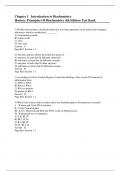Chapter 1 Introduction to Biochemistry
Horton: Principles Of Biochemistry 4th Edition Test Bank
1) Wohler showed that a chemical found only in living organisms can be made from inorganic
M
substances when he synthesized ________.
A) Ammonium cyanate
B) Amino acids
ED
C) Urea
D) Uric acid
Answer: C
Page Ref: Section 1-1
2) The lock-and-key theory described the action of
C
A) enzymes as keys that fit different chemicals.
B) substrates as keys that fit different enzymes.
C) enzymes as locks that fit other enzymes.
O
D) substrates as locks that fit different enzymes.
Answer: B
Page Ref: Section 1-1
N
3) According to Crick's Central Dogma of molecular Biology, there can be NO transfer of
information from
N
A) DNA to RNA.
B) RNA to RNA.
C) RNA to protein.
O
D) protein to RNA.
Answer: D
Page Ref: Section 1-1
IS
4) What is the correct order in which these key breakthroughs in biochemistry occurred?
I. Watson and Crick DNA structure
II. Crick Central dogma
SE
III. Avery, MacLeod and McCarty DNA work on Streptococcus
IV. Widespread use of computers
A) I, II, III, IV
B) III, I, II, IV
C) II, I, III, IV
U
D) IV, III, I, II
Answer: B
Page Ref: Section 1-1
R
, 5) Which elements account for more than 97% of the weight of most organisms?
A) C, H, N, Mg, O, S
B) C, H, N, O, P, S
C) C, H, N
D) Fe, C, H, O, P
M
E) Ca2+, K+, Na+, Mg2+, Cl-
Answer: B
Page Ref: Section 1-2
ED
6) Which linkage(s) occur extensively in nucleotides?
A) Amide.
B) Phosphoanhydride.
C) Phosphate ester.
D) Ether.
E) Both B and C above.
C
Answer: E
Page Ref: Section 1-2
O
7) Which functional group is shown?
N
N
O
A) Primary amine.
B) Acyl.
C) Amide.
IS
D) Anhydride.
E) Nitrile.
Answer: C
Page Ref: Section 1-2
SE
8) Proteins in biological membranes may be
A) porous.
B) attached to the membrane surface.
C) span the membrane.
U
D) all of the above.
E) B and C only.
Answer: D
R
Page Ref: Section 1-3
, 9) A dipeptide forms when a functional ________ group of one amino acid reacts with the
functional ________ group of another amino acid to form a ________ bond.
A) carboxylate, amino, double
B) carboxylate, amino, enzyme
C) amino, carboxylate, phosphate
M
D) amino, carboxylate, peptide
Answer: D
Page Ref: Section 1-3
ED
10) Sugars such as glucose are monomers of polysaccharides that are linked together when
covalent bonds form between one ________ group of one sugar to the same group on another
sugar.
A) ester
B) carboxyl
C) amino
C
D) hydroxyl
Answer: D
Page Ref: Section 1-3
O
11) Which statement about cellulose is false?
A) It is the most abundant polysaccharide in nature.
N
B) Its monomers are joined by glycosidic bonds.
C) It is present in the stems of flowering plants.
D) The hydroxyl groups of neighboring cellulose molecules interact to form strong, insoluble
N
fibers.
E) It is a branched polymer of glucose.
Answer: E
O
Page Ref: Section 1-3
12) When Keq of a reaction = 1, then
IS
A) the forward reaction is faster than the reverse reaction.
B) the reverse reaction is faster than the forward reaction.
C) the forward and reverse reaction rate constants are equal.
D) more products are formed than reactants.
SE
E) fewer products are formed than reactants.
Answer: C
Page Ref: Section 1-4
13) Most of the energy required for life on Earth is supplied by ________.
U
A) geothermal energy
B) the sun
C) cosmic radiation
R
D) the conversion of ADP to ATP
E) mechanical energy
Answer: B
Page Ref: Section 1-4
, 14) Which statement is true about the Gibb's free energy of a reaction?
A) It is dependent on the concentrations of both products and reactants.
B) It is dependent only on the concentrations of the reactants.
C) It is dependent only on the concentrations of the products.
D) It is not dependent on the concentrations of either the products or reactants.
M
Answer: A
Page Ref: Section 1-4
15) Which statement is true about a reaction with an equilibrium constant, Keq, equal to 1000?
ED
A) The forward rate constant is 1000 times greater than the reverse rate constant.
B) The forward rate constant is 3 times greater than reverse rate constant.
C) The forward rate constant is 1000 times smaller than the reverse rate constant.
D) The forward rate constant is 3 times smaller than the reverse rate constant.
E) There is not enough information given to compare the forward and reverse rate constants.
Answer: A
C
Page Ref: Section 1-4
16) If a reaction is at equilibrium, what is the free energy change?
O
A) It is always positive.
B) It is always negative.
C) It could be either positive or negative depending on the reaction.
N
D) It equals zero.
Answer: D
Page Ref: Section 1-4
N
17) Which statement is true?
A) If DG is negative, then the rate of the reaction will be fast.
O
B) If DG is positive, then the rate of the reaction will be fast.
C) If DG is negative, then the rate of the reaction will be slow.
D) If DG is positive, then the rate of the reaction will be slow.
IS
E) The reaction rate is independent of DG.
Answer: E
Page Ref: Section 1-4
SE
18) The study of the energy changes during metabolic reactions is called ________.
A) bioinformatics
B) metabodynamics
C) thermometrics
D) bioenergetics
U
E) biological heat dynamics
Answer: D
Page Ref: Section 1-4
R




